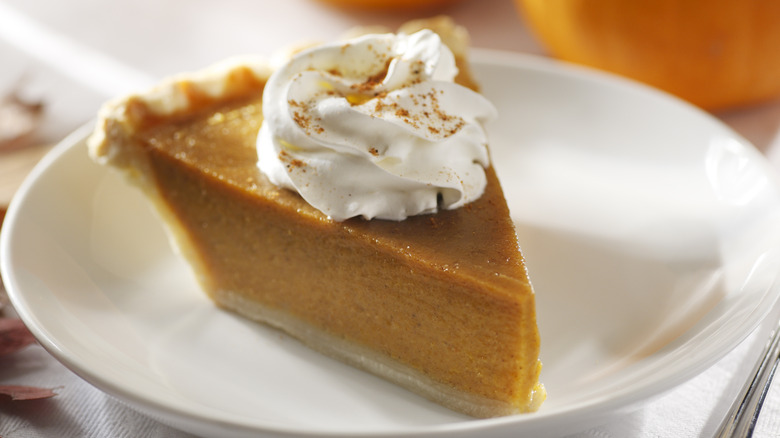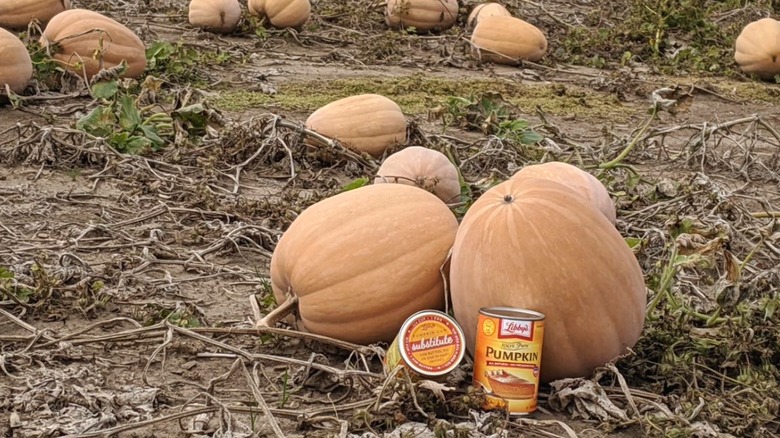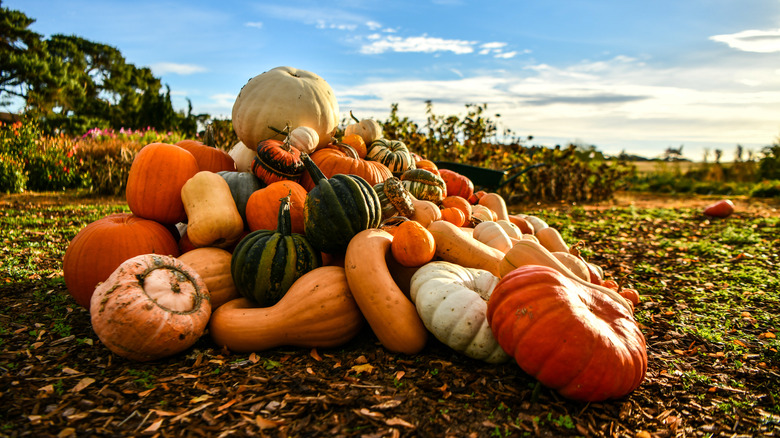The Only Pumpkin Variety Costco Uses For Pie
Between bulk deals and Kirkland brand products, Costco is beloved by its members for its shocking selection of goods. The wholesaler stocks virtually any item you could need for any occasion, making it a must-stop shop for the holidays. When Thanksgiving rolls around, it's natural to look for help wherever you can get it — especially with cooking and baking. For many shoppers, Costco is a saving grace. Besides dips, sides, and whole turkeys, the warehouse is packed with pumpkin pies every fall. At over 3 ½ pounds for only $5.99, each dessert can affordably feed a whole host of hungry mouths. And when paired with the Kirkland brand vanilla ice cream (made by an external supplier), everyone will be pleased.
It's not too surprising then that each year, according to David and Susan Schwartz's book "The Joy of Costco: A Treasure Hunt From A to Z," Costco members buy 6 million pumpkin pies. Over 2 million pies are sold right before Thanksgiving alone in anticipation of the approaching family feeding frenzy. With so many sold every season, it's worth looking at what's used to make the popular pie, particularly the pumpkin variety: The Dickinson pumpkin.
Unlike Costco's pumpkin pie or the kind of pumpkin carved during Halloween, the Dickinson pumpkin isn't orange, nor can it be bought whole at the grocery store. The internet has even spent years discussing whether or not the Dickinson pumpkin variety is really a pumpkin at all. Just as special as the signature pies it's in, here's what you should know about the deceptive yet delicious Dickinson pumpkin.
Dickinson pumpkins are the star of the dessert
When you think of the type of pumpkin used to make a pie, you might picture the bright orange gourd used for jack-o'-lanterns. However, this bright orange variety is the aptly named Captain Jack pumpkin, used primarily for carving, not cooking. The standard pumpkin for pies — including Costco's and any you might bake at home — is the Dickinson pumpkin, which is tan, tall, and often oblong. This variety is used for most canned pumpkin products, about 90% of which in North America is supplied by Libby's.
Farmer Elijah Dickinson began growing the eponymous pumpkin in Kentucky in the early 1800s, eventually planting seeds in Illinois instead, where they're still predominantly produced today. Canned food company Libby's, owned by Nestlé, later took on the agricultural project for its canned pumpkin products. Since Dickinson's days in the field, the brand tweaked the original cultivar to grow a pumpkin with even sweeter, denser fine-grained flesh — perfect for pie-making. The Dickinson pumpkin is also used for savory dishes, from pasta to Thai-inspired coconut and pumpkin soup. Since it's sold by the seed, you'll only be able to score one at a farmer's market or if you grow it yourself. The other option? Buy a can of Libby's pumpkin puree.
After all, that's what Costco does, just in bulk. According to David and Susan Schwartz, the aforementioned big-box store experts, the wholesaler uses about 1.2 million cans of Dickinson pumpkin puree for its pies annually. Clearly, the warehouse bakeries work hard, turning orange goop into delectable desserts.
Are Dickinson pumpkins actually pumpkins?
In the fall of 2016, a Food & Wine article (since removed from the magazine's website) circulated online claiming that pumpkin puree wasn't actually pumpkin at all. Just in time for Thanksgiving, the article alleged that Libby's had been misleading consumers, using various winter squash for its canned pumpkin products. Pumpkin pie? More like butternut squash pie. However, the claims were debunked by Snopes. The fact-checking website cleared up the confusion, which partly stemmed from the classification of Dickinson pumpkins. Turns out, the pie-worthy variety is a pumpkin. And also a squash. Naturally, it's easy to see why the author of the pot-stirring article was up in arms.
So how's it possible for both to be true? The answer is simple but not nearly as satisfying as pie: There isn't a strict botanical definition of a pumpkin. In fact, all "pumpkins" are squash — even the jack-o'-lantern variety. In addition to gourds, all of them are part of the expansive Cucuburitaceae family. Dickinson pumpkins are of the Cucurbita moschata species, which includes butternut squash, illuminating why the two are so similar in color and sometimes shape.
But unlike traditionally photogenic pumpkins, Dickinson pumpkins are better for eating. Bred for carving, field pumpkins are stringy, grainy, and thin-fleshed, which is why you shouldn't dispose of pumpkin pulp in the kitchen sink. While the seeds are tasty when roasted, if you're baking a pie (or buying one from Costco), the Dickinson pumpkin provides the signature sweet flavor and creamy texture that many Americans love.


